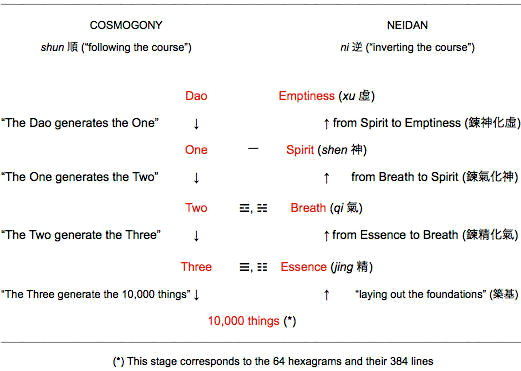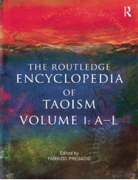Jindan
Golden Elixir
Reproduced from:
Fabrizio Pregadio, "Jindan"
In The Encyclopedia of Taoism, vol. 1, pp. 551-55
Edited by Fabrizio Pregadio
Routledge, 2008
The Encyclopedia of Taoism
● Table of Contents and List of Contributors
Sample Entries
● Daode jing (Scripture of the Dao and Its Virtue)
● daojia (Taoism; "Lineage[s] of the Way")
● daojiao (Taoism; Taoist teaching; "Teaching[s] of the Way")
● Daozang (Daoist Canon) and Subsidiary Compilations
● jiao (Offering)
● jindan (Golden Elixir)
● Lingbao (Numinous Treasure)
● Quanzhen (Completion of Authenticity)
● Shangqing (Highest Clarity)
● Tianshi dao (Way of the Celestial Masters)
Modern studies usually refer to the Chinese arts of the elixirs as Waidan (External Alchemy) or Neidan (Internal Alchemy), but the authors of alchemical texts often call their tradition the Way of the Golden Elixir (jindan zhi dao). Gold (jin) represents the state of constancy and immutability beyond the change and transiency that characterize the manifested world. As for dan, or "elixir," lexical analysis shows that the semantic field of this term — which commonly denotes a variety of red — evolves from a root-meaning of "essence," and that its connotations include the reality, principle, or true nature of an entity, or its most basic and significant element, quality, or property.
In its various formulations, the Way of the Golden Elixir is characterized by a foundation in doctrinal principles, first set out in the founding texts of Taoism, concerning the relation between the Dao and the world of multiplicity. Waidan and Neidan are two paradigmatic forms of practice, with several varieties for each of them, devised on the basis of those principles. Both forms of practice are centered on the notion of refining (lian) the ingredients of the outer or the inner elixir — inanimate matter in Waidan, and the primary constituents of the cosmos and the human being, namely essence, pneuma, and spirit (jing, qi, shen), in Neidan. The Chinese alchemical tradition has therefore three aspects, namely a doctrinal level and two main forms of practice, respectively based on the refining of an "outer" or an "inner" elixir.
The Elixir in "External Alchemy"
The Taiqing (Great Clarity) sources, which belong to the first identifiable tradition associated with Waidan practices, contain virtually no statements on their doctrinal foundations. The emphasis given to certain aspects of the methods, and the terminology used in their descriptions, however, show that the central act of the alchemical process consists of causing matter to revert to its "essence" (jing), or materia prima. The main role in this procedure is played by the crucible (fu), which functions as a medium equivalent to the inchoate state (hundun) that precedes the formation of the cosmos. In that medium, under the action of fire, the ingredients of the elixir are transmuted, or "reverted" (huan), to their original state. Quoting Daode jing 21 ("Indistinct! Vague! But within it there is something. Dark! Obscure! But within it there is an essence"), the commentary to the Jiudan jing (Book of the Nine Elixirs) equates this purified matter with the "essence" issued from the Dao that gives birth to the cosmos (Huangdi jiuding shendan jingjue; CT 885, 10.1b).
Among a large variety of methods, two progressively became typical of Waidan. The first consists of refining mercury (Yin) from cinnabar (Yang). The refined essence (feijing) is added to sulphur (Yang) and is then refined again, typically in seven or nine cycles. At each stage it becomes more Yang, until it incorporates the properties of Pure Yang (chunyang), the state prior to the differentiation of the One into multiplicity. In the second method, described in Waidan texts related the Zhouyi cantong qi (The Seal of the Unity of the Three in Accordance with the Book of Changes), the initial ingredients are cinnabar (Yang) and native lead (Yin). They are refined to produce Real Mercury (zhenhong), which is Original Yin, and Real Lead (zhenqian), which is Original Yang, respectively. The elixir obtained through combining the two refined essences also represents Pure Yang.
Alchemy and Cosmology
In the traditions based on the Cantong qi, alchemy is primarily a figurative language used to represent the relation between the Dao and the cosmos, the Absolute and the relative, Oneness and multiplicity, and timelessness and time. In these traditions, the emblems of correlative cosmology — typically arranged in patterns that include Yin and Yang, the five agents (wuxing), the eight trigrams and the sixty-four hexagrams of the Yijing (Book of Changes), and so forth — play two main roles. First, they represent the different cosmological configurations produced by the propagation of Original Pneuma (yuanqi) into the "ten thousand things." In this function, the emblems of correlative cosmology show how space, time, multiplicity, and change are related to the spacelessness, timelessness, non-duality, and constancy of the Dao. For instance, the Cantong qi describes the five agents — which define, in particular, the main spatial and temporal coordinates of the cosmos — as unfolding from the center, which contains them all, runs through them, and "endows them with its efficacy." In their second role, the emblems of correlative cosmology relate the alchemical practice to doctrinal principles. For instance, the trigrams of the Book of Changes are used to show how the alchemical process consists of extracting the precosmic Real Yin (zhenyin) and Real Yang (zhenyang) from Yang and Yin as they appear in the cosmos, respectively, and in combining them to produce an elixir that represents their unity.
The Elixir in "Internal Alchemy"
The doctrines expounded in the treatises on the "inner elixir" essentially consist of a reformulation of those enunciated in the early Taoist texts, integrated with language and images drawn from the system of correlative cosmology according to the model provided by the Cantong qi. The authors of doctrinal treatises point out that the alchemical teachings can only be understood in the light of those of the Daode jing (a text they consider to be "the origin of the Way of the Golden Elixir"), and that correlative cosmology provides "images" (xiang) that serve, as stated by Li Daochun (fl. 1288-92), "to give form to the Formless through words, and thus manifest the authentic and absolute Dao" (Zhonghe ji, 3.13a-b; see Robinet, Introduction à l'alchimie intérieure taoïste, 75-76).
The relation of doctrine to practice was an issue that needed clarification among Neidan adepts themselves, as shown by Chen Zhixu (1289-after 1335) who forcefully rejects the understanding of alchemy as merely consisting of techniques of self-cultivation, when he writes: "It has been said that the way of cultivation and refinement consists of the techniques (shu) of the Yellow Emperor (Huangdi) and Laozi. No more of this nonsense! This is the great Way of the Golden Elixir, and it cannot be called a technique" (Jindan dayao, 3.4b). Chen Zhixu and other authors emphasize that the inner elixir is possessed by every human being, and is a representation of one's own innate realized state. Liu Yiming (1734-1821) expresses this notion as follows:
Human beings receive this Golden Elixir from Heaven. . . . Golden Elixir is another name for one's fundamental nature, formed out of primeval inchoateness (huncheng, a term derived from the Daode jing). There is no other Golden Elixir outside one's fundamental nature. Every human being has this Golden Elixir complete in himself: it is entirely realized in everybody. It is neither more in a sage, nor less in an ordinary person. It is the seed of Immortals and Buddhas, and the root of worthies and sages. (Wuzhen zhizhi, chapter 1)
In his explication of two terms that the Cantong qi borrows from the Daode jing, Liu Yiming describes "superior virtue" (shangde) as the immediate realization that the original "celestial reality" (tianzhen) within and outside of oneself is never affected by change and impermanence, and "inferior virtue" (xiade) as the performance of the alchemical practice in order to "return to the Dao." He states, however, that the latter way, when it achieves fruition, "becomes a road leading to the same goal as superior virtue" (Cantong zhizhi, "Jing," chapter 2).
Although the Neidan practices are codified in ways that differ, sometimes noticeably, from each other, the notion of "inversion" (ni) is common to all of them (Robinet, Introduction à l'alchimie intérieure taoïste, 131-45). In the most common codification, the practice is framed as the reintegration of each of the primary components of existence (essence, pneuma, and spirit) into the one that precedes it, culminating in their "reversion" (huan) to the state of Non-being, or Emptiness (wu, xu, kong). The typical formulation of this process is "refining essence into pneuma" (lianjing huaqi), "refining pneuma into spirit" (lianqi huashen), and "refining spirit and reverting to Emptiness" (lianshen huanxu). Li Daochun relates these stages to the cosmogonic process outlined in Daode jing 42: "The Dao generates the One, the One generates the Two, the Two generate the Three, the Three generate the ten thousand things." In this sequence (see table 15), the Dao first generates Oneness, which harbors the complementary principles of Yin and Yang. After Yin and Yang are differentiated from each other, they rejoin and generate the "three," reestablishing Oneness at the level of the particular entities. The "ten thousand things" are the totality of the entities produced by the continuous reiteration of this process. In Li Daochun's explication, the three stages of the Neidan practice represent the inversion of this process, leading from the "ten thousand things" to Emptiness, by means of the elimination of distinctions between each of the primary components of existence and the one immediately above it.

|
For Li Daochun and other authors who refer to it, the form of practice outlined above is the only one that matches the principles of the Way of the Golden Elixir. In an essay found in his Zhonghe ji (2.11b-17a), Li thoroughly rejects sexual practices and Waidan, and assigns a low rank to physiological practices (including daoyin, breathing techniques, and diets) and methods of meditation and visualization. As for Neidan proper, he distinguishes three "vehicles" (sheng) that may be characterized as physiological, cosmological, and spiritual. Above them is a Supreme One Vehicle (zuishang yisheng), which he calls the "Wondrous Way of Supreme and Utmost Reality" and does not associate with any particular practice. Especially important in Li Daochun's essay is the idea of "point of application" or "point of operation" (zuoyong chu), according to which certain notions and practices take on different meanings and operate in different ways according to the level at which they are understood.
Fabrizio PREGADIO














